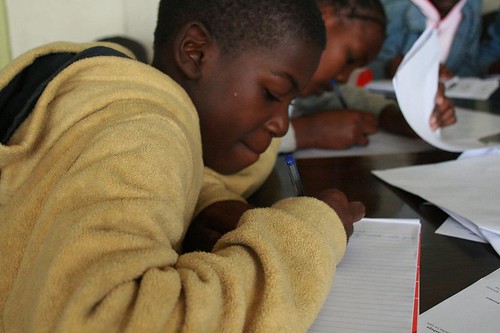Great Tips for Teaching Writing To Language Learners
Teaching Literacy as a whole? Check out our literacy resource page with articles, links, and more to get you started!
It’s amazing how often speaking ability doesn’t translate to writing ability with foreign language learners. In fact, they use different parts of the brain so it’s not uncommon to meet dazzling conversationalists who can barely compose an intelligible email. If you’re a teacher of language, it’s your job to bridge this gap, not only helping your students to write great sentences, but also organizing their thoughts into complete letters, essays, papers, or even books.
Never fear, because Open Equal Free’s Literacy Resources and Ed Tips are here to help! In this article, we’ll give you a bird’s eye view of teaching writing: how to help your students get past their fears, organize their ideas, and communicate effectively.
Don’t Lose Focus, Write for a Reason!
Why do we write? To communicate ideas, of course! This is perhaps one of the most important rules for teaching writing. The more you have your students write to communicate an idea effectively to another person, the better. Sure, that person can be you, but why not to another student, or better yet, a whole group of them?
Instead of having a student write a biography she quietly turns in, why not have her write a biography of a famous person without stating the name? Then, have her read the biography out loud to the class. If the class can guess who the bio is about, the student did a good job. If the class can’t guess who they’ve written about, she needs to get back to work!
This can work with almost any writing assignment. Instead of making the goal to “get an A,” the goal becomes to “use your writing to communicate an idea effectively.” Not only do students immediately know whether they’ve succeeded or not, but they also understand why they’ve failed, and the reason they’ve failed goes straight to the heart of writing: They didn’t get their ideas across to their readers.
Build Strong Writers, Don’t Expect To Birth Them
It’s one of the oldest plays in the teacher book: Scaffolding. Most teachers know that you can’t take your students from zero to sixty without some steps in between. What many teachers are unable to accept is that sometimes you can’t take your students from zero to two without that crucial step in the middle.
 Whenever your students are having difficulty with anything, the best thing you can do is stop, rewind, and break the lesson into smaller pieces. We have a whole article on scaffolding coming down the pipeline, but until then, here’s how to break writing down into manageable bites.
Whenever your students are having difficulty with anything, the best thing you can do is stop, rewind, and break the lesson into smaller pieces. We have a whole article on scaffolding coming down the pipeline, but until then, here’s how to break writing down into manageable bites.
First of all, think long and hard about what you’re teaching. Are you teaching writing? Writing and vocab? Writing, vocab, and grammar? Even if you are teaching multiple things, or expect your students to negotiate multiple new language concepts, the trick is to walk them through them so that they’re only tackling one at a time.
For example, let’s say you want them to write a restaurant review. If you try to get a bunch of beginning language learners to not only organize their thoughts, but also generate vocabulary and decide what tenses and phrasing are appropriate for a review article all at once, you’re likely setting them up for failure. Break it down!
Like all scaffolding, how many of these steps you’ll have to do depends on the level of your students and what your objectives for the lesson are, but, here are some bites you can help them take during your lesson:
Set the Context
In the beginning of the lesson you would set the context and elicit enough vocabulary words and related language for them to use in their writing. Even if they have a pretty solid vocabulary it just adds another burden for them to carry while they try to learn to write. Why not teach the vocab and phrasing they’ll need separately so that they can focus on organizing their ideas and communicating effectively?
 Show An Example
Show An Example
This step can get dicey quickly, especially in contexts where students are used to simply copying from a teacher on the board. The best way to avoid this is by providing the example early on, and then removing it before moving on to any other steps. This could happen after you’ve generated vocabulary and structure, or, depending on your students (maybe they have a lot of vocabulary but not much confidence writing, or maybe they’ve been writing for a while but don’t have much vocabulary around this specific subject).
Generate Some Structures
Another great pre-writing activity is to generate actual grammatical structures students might use. For restaurant reviews, this could be as easy as reviewing simple past tense. For other assignments you may want to generate some language that might be difficult for them. The key, of course, is to modulate how much you give them, and how directly applicable it is to the level of your students.
For early beginners, you may be using elicitation to generate almost every sentence as a class, leaving students to simply arrange the ideas in the appropriate order. For more advanced classes, you may generate a couple of examples that they are expected to rewrite and expand entirely on their own.
Use Graphic Organizers
Generating and organizing ideas and constructing the language to share them are two different tasks. If you ask students to do all of that at once and they face difficulties, a graphic organizer step will help you pull the process apart and give your students the tools they need to build to the point where they can do these steps at once, independently. You can find links to graphic organizers on our literacy page.

Editing & Rewriting
Constructive criticism is great, and providing it is certainly a large part of your job as a teacher, but it is possible to criticize too much. How many new ideas would you expect your students to absorb in a single class? Three? Four? Maybe five? You certainly wouldn’t introduce all of the tenses in first and third person in a single beginner class, it would be too much.
Likewise, if students have made a dozen mistakes in their papers, do you think they can internalize and learn from all of them in one go?
Probably not.
Instead, tell your students that, for each paper, you’ll pick about three to five of the most important conventions errors and focus on those. Remember to emphasize that the focus goes both ways. You’ll be focusing on a few of their mistakes, and you expect them to focus on improving those for the next paper.
Grading
Have a grading rubric. Share it with your students. I’ve never been a fan of percentile grades for writing. How some teachers differentiate between an essay scored at 97% and one scored at 98% without being arbitrary, or over-focusing on conventions, is beyond me. A common answer is to choose a scale, usually from one through five or six. That’s more useful when talking about writing. Then translate the score into whatever grading system your school uses. Need a place to start? Check out this example from Florida.
Creative Commons Love: Global Partnership for Education, Keith Williamson, Krosinsky, and Jeffrey James pacres on Flickr.com










 We’re not going to get into the middle of that messy, messy debate. The goal of this series is to let you know the components of literacy, and therefore of holistic literacy assessment. Be warned that, although these skills do tend to develop in tandem, it is absolutely possible to create young “readers” who can decode and fluently read a block of text quite beautifully while not comprehending much, if anything at all.
We’re not going to get into the middle of that messy, messy debate. The goal of this series is to let you know the components of literacy, and therefore of holistic literacy assessment. Be warned that, although these skills do tend to develop in tandem, it is absolutely possible to create young “readers” who can decode and fluently read a block of text quite beautifully while not comprehending much, if anything at all.



